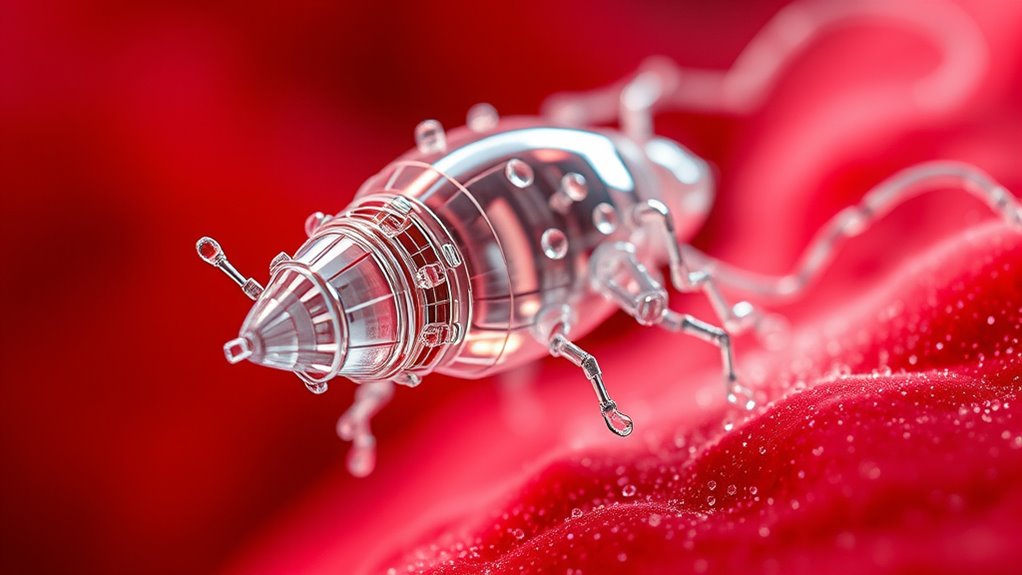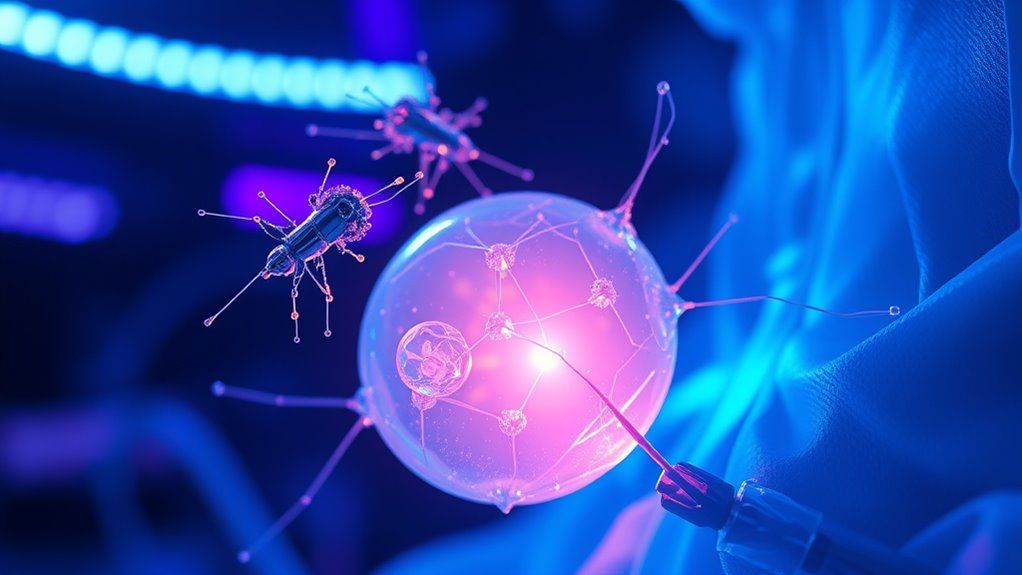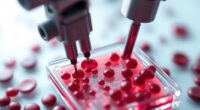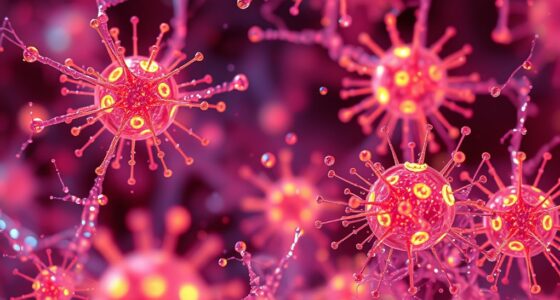The future of nano-surgery will transform how you receive medical care by using tiny robots that target cells precisely, reducing side effects and improving outcomes. These nanobots will work together, communicate, and customize treatments based on your genetic makeup, enabling early diagnosis and minimally invasive therapies. This shift towards microscopic interventions promises better health management, less discomfort, and proactive disease prevention. If you want to discover how these innovations will unfold, there’s much more to explore.
Key Takeaways
- Nanobots will increasingly collaborate via networks to enhance treatment precision and efficiency.
- Personalized nanobot therapies will be tailored to individual genetic profiles for higher effectiveness.
- Nano-surgery will enable minimally invasive, targeted treatments that reduce side effects compared to traditional methods.
- Early disease detection through nanobots will shift healthcare toward proactive, preventive approaches.
- Ongoing research will expand applications, making nano-surgery a core component of future personalized medicine.

Nano-surgery is rapidly transforming medicine by enabling precise interventions at a cellular level, opening new possibilities for treating diseases that were once deemed incurable. At the heart of this revolution are nanobots—microscopic devices designed to navigate your body with extraordinary accuracy. These nanobots leverage nanobot precision to identify and target specific cells, bacteria, or malfunctioning tissues, making treatments more effective while minimizing collateral damage. Instead of broad-spectrum approaches like chemotherapy or invasive surgeries, targeted therapy with nanobots allows you to address the root cause of health issues directly, reducing side effects and recovery times.
Nano-surgery uses nanobots for precise, targeted treatments, reducing damage and improving health outcomes.
Imagine a future where you no longer need invasive procedures or lengthy hospital stays. Instead, tiny nanobots are dispatched into your bloodstream, where they patrol and monitor your body’s internal environment. When they detect an abnormal cell or pathogen, they can precisely deliver medication, remove blockages, or repair damaged tissues—all at a cellular level. This level of precision not only improves outcomes but also opens the door for early detection of diseases, catching issues long before symptoms appear. The ability to perform such targeted therapy could revolutionize how you approach health management, shifting from reactive treatments to proactive prevention.
As nanobot technology advances, you’ll benefit from increasingly sophisticated capabilities. These devices will be able to communicate with each other, forming coordinated networks that enhance their efficiency and scope. For example, in cancer treatment, nanobots could work together to seek out tumor cells, deliver chemotherapy drugs directly to the cancerous tissue, and then clear away any debris—all without harming surrounding healthy cells. This targeted therapy reduces the common side effects associated with traditional treatments, like hair loss or nausea, because it spares your healthy tissues from exposure.
Moreover, nanobots will likely be customizable to your specific health needs. Using detailed genetic and medical data, doctors could program nanobots tailored to your unique biology. This personalized approach ensures that treatments are optimized for your body’s particular characteristics, increasing their effectiveness. The combination of nanobot precision and targeted therapy means you’ll enjoy therapies that are not only more effective but also less invasive, paving the way for a future where diseases are managed at a microscopic level before they escalate.
In essence, the future of nano-surgery promises a paradigm shift in medicine—one where microscopic devices perform complex, targeted interventions with accuracy that surpasses traditional methods. This innovative approach could dramatically improve your health outcomes, reduce risks, and make treatments more comfortable and less disruptive. As research progresses, you’ll see nanobot-enabled therapies becoming an integral part of personalized medicine, transforming how you and future generations will manage health and disease. Furthermore, ongoing research into nanomedicine applications continues to expand the potential uses of nanobots beyond current expectations, promising even more innovative treatments ahead.
Frequently Asked Questions
What Are the Current Limitations of Nano-Surgical Tools?
You face challenges with nano-surgical tools due to miniaturization issues, making it hard to develop precise, functional devices at such small scales. Material durability also poses a problem because these tools must withstand harsh biological environments without breaking down. Additionally, controlling and powering these tiny devices remains complex, limiting their current applications. Overcoming these limitations requires advances in materials science and miniaturization techniques to improve safety and effectiveness.
How Long Will Nano-Surgery Devices Last Inside the Human Body?
Sure, nano-surgery devices are designed to last forever—just kidding. In reality, their durability varies based on materials and usage, but most are expected to last months to a few years inside the human body. The longevity of nano devices depends on factors like biocompatibility, corrosion resistance, and how well they’re maintained. So, rather than eternal guardians, think of them as temporary yet highly effective surgical assistants.
Are There Ethical Concerns With Nano-Surgery Automation?
You might worry about ethical concerns with nano-surgery automation, especially regarding autonomy concerns and moral implications. As devices become more autonomous, questions arise about decision-making authority and accountability. You should consider how to guarantee these systems operate ethically, respecting patient rights and safety. Developing clear guidelines and oversight can help address moral implications, ensuring nano-surgery automation benefits patients without compromising moral standards or autonomy.
What Are Potential Risks of Nano-Surgery in Non-Human Applications?
You face potential risks of toxicity and environmental impacts with nano-surgery in non-human applications. Toxicity risks arise if nanomachines release harmful substances or interact unpredictably with biological systems. Environmental impacts include contamination from nanomaterials entering ecosystems and affecting wildlife. These risks demand careful regulation, thorough testing, and responsible use to prevent unintended harm to ecosystems and non-human life, ensuring safe advancement of nano-surgery technologies beyond human medicine.
How Will Nano-Surgery Impact Existing Healthcare Infrastructure?
Nano-surgery will substantially impact healthcare infrastructure by requiring seamless healthcare integration and infrastructure adaptation. You’ll see advanced equipment and specialized training becoming essential, pushing hospitals to upgrade their facilities. This integration will enable real-time diagnostics and minimally invasive procedures, improving patient outcomes. However, it also demands substantial investment and regulatory oversight to guarantee safe implementation, ultimately transforming healthcare delivery into a more precise and efficient system.
Conclusion
As you explore the future of nano-surgery, you’ll be amazed by its potential to revolutionize healthcare. With researchers predicting that by 2030, over 70% of surgeries could involve nanotechnology, the possibilities are thrilling. Imagine tiny robots repairing cells at a molecular level, reducing recovery times and improving outcomes. This emerging field promises a future where diseases are targeted more precisely than ever before, making health treatments more effective and personalized for everyone.









